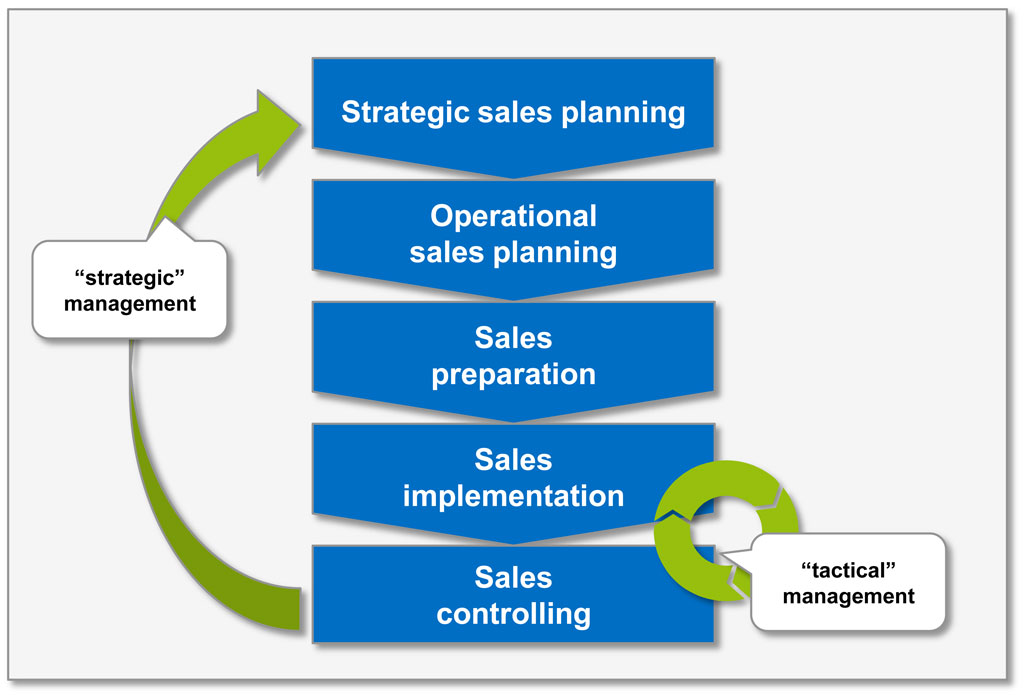We define “sales management” as a comprehensive management approach consisting of strategic and operational sales planning, preparation and implementation as well as controlling. Contrary to the—to our mind—necessary active support of sales management, we tend to a more passive attitude in the sense of “sales management” in many banks.
In order to cope with the challenges of complex regulations, individualized and changing customer needs and increasing competitive pressure, we recommend to shape sales management by introducing an active sales approach for exploiting earning potentials in sales.
Shaping sales management in such a way allows for a targeted interaction between sales and customers and leads to sales growth—and thus in the end also to increasing total bank results.
Selecting the management approach
The selection of the management approach—which lays the strategic foundation for the work of the sales management—becomes the content-related starting point for sales management. It actively shapes sales and therefore allows for a high standardization on the one hand and appropriate degrees of freedom for sales on the other hand. The aim is a common interaction for corporate success.
The level of ambition (usually desired earnings) is defined within the strategic sales planning while considering earning potentials in the operating district. The sales targets are defined in the potential-oriented sales plan in form of target values according to the region of the operating district. Additionally, the selection and/or use of sales channels is defined as another dimension.
From the sales plan to a binding and topic-specific annual plan
After having defined the strategic alignment, the sales plan has to be transferred into a concrete, topic-specific annual plan with binding specifications for the individual sales units within the operational sales planning. Target cards for the individual units are developed, from which sales measures for higher potential exploitation can be derived. The four dimensions of performance, activities, efficiency and quality are to be considered as drivers of the P&L result both for new customers as well as for existing customers, who are often neglected. Thus, planning is systematized and specified in form of potential-oriented measure packages for the individual business units.
A comprehensible sales preparation is to be made prior to the implementation phase, which is critical for success. It includes—from our point of view—actively supporting the customer advisor in the area of product and customer management incl. defining the support ratio and generating contacts.
After having prepared both the support of new and existing customers in detail, the operational phase of sales implementation begins. Here, respective degrees of freedom are defined for sales by passing on the implementation of the implemented management within defined standards. It is to be supported by the executives of the unit. The sales management also makes a contribution in form of process and system support.
Quantifying sales success
With regard to the efficiency of the implemented measures of the operational sales plan, figures are of paramount importance. Quantifying the sales success is a prerequisite for targeted sales management. Sales employees cannot be managed in a targeted manner without any sales controlling on activity level. Thus, it has to be considered while developing an information system for executives to represent the relevant dimensions of performance, activities, efficiency and quality in management-relevant and fee-relevant KPIs. The core of the information system is a central, coherent sales reporting of manageable scope. The reporting should be structured in a user-oriented and cascaded way, since not all information is relevant for all executives. A targeted communication of results enables the different sales areas to detect undesirable developments at an early point and take countermeasures, if needed. We recommend to implement an institutionalized, cross-departmental management dialog, where current figures and topics can be discussed on a regular basis in order to allow for an interaction of all specialized units, that influence sales performance (e.g. product and sales management). A direct exchange between the sales management and sales units and/or sales executives based on figures, data and facts generated within sales controlling, is referred to as “tactical sales management”. The feedback to strategic sales planning in a closed management cycle, which considers figures, data and facts from sales controlling as actual values of sales controlling, is called “strategic management”.
Separating sales management and controlling as organizational units is advisable in larger institutions in order to ensure an appropriate sales support for increasing sales performance.
If you or other interested employees of your company have an opinion on our assessment and would like to discuss it with us, then please do not hesitate to contact us directly on BankingHub or via our social media pages.


